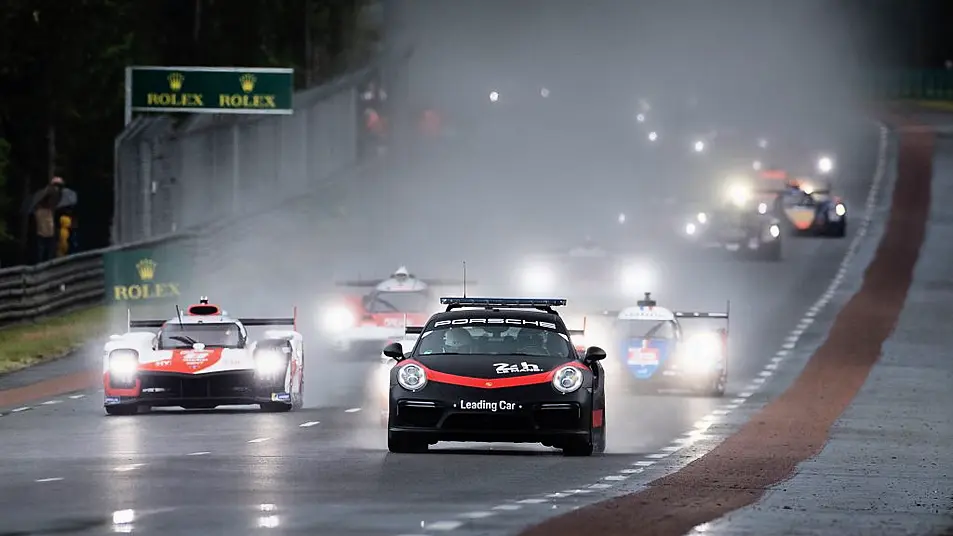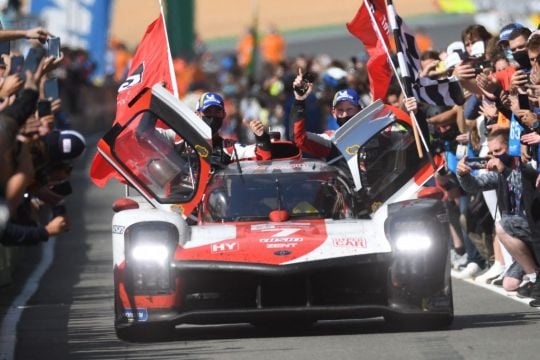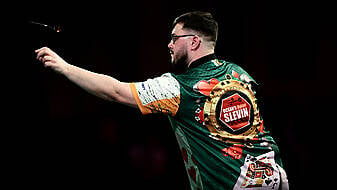Although the result of the 89th running of the 24hrs of Le Mans may well look familiar — Toyota won, as it has done each year since 2017 — the fact is that the Japanese giant won while hobbled by a fuelling problem which forced its cars to pit more frequently than planned may have teams like BMW, Audi, Ferrari, Porsche, and Peugeot kicking themselves.
Before the race began, Toyota Gazoo Racing manager Pascal Vassellon predicted a mere 20 minutes too long spent in the pitlane could lose Toyota the race. In the event, the extra stops for fuel did not prevent the team from winning, and the top step of the podium was finally occupied by the car long-considered the ‘unlucky’ Toyota — the No.7 car of Mike Conway, Jose Maria Lopez, and Kamui Kobayashi.
In many ways, the 2021 running of the race was something of a placeholder event. This is the first year of the new ‘Hypercar’ rulebook, that replaces the old top-spec Le Mans cars, known as LMP1 machines, with something almost as fast, but much more affordable to design and run.
Indeed, Toyota’s GR010 hybrid-engined racer was supposed to have spawned a road-going variant, but that has been back-boilered — possibly even cancelled altogether — following a crash involving the only prototype. So far, Toyota is the only carmaker to sign up to the Hypercar rule book and to have a car on the track. Peugeot and Ferrari have also committed to the sport, and will enter Le Mans in 2023 with its dramatic ‘Hypercar’ entries.
BMW, Porsche, and Audi have committed to the so-called LMDH rule set — which seeks to equalise the performance and design of cars that race at Le Mans with those that race in the American IMSA series, and will also all be on the grid in 2023. Others, including Mazda, Cadillac, McLaren, and even Lamborghini rumoured to be entering while Hyundai is reportedly showing interest in the just-announced 2025 rules that will allow cars running a hydrogen fuel cell.
Regret
How much will those brands and teams be kicking themselves that they did not get a car on the grid this year? Probably quite a lot — Toyota’s fuelling problems would have opened up a massive opportunity for a fast-charging rival.
As it was, Renault’s sports car brand Alpine — running a two-year-old design under the so-called ‘Grandfather’ rules and American privateer Glickenhaus — owned by Jim Glickenhaus, who made a fortune in film production in the 1980s, and seems set on spending every cent of it in building fast and beautiful racing cars — did not have the pace nor consistency to challenge even a hobbled Toyota.
Glickenhaus’ cars looked great, and had some real driving talent on hand, not least former multiple Le Mans winner Romain Dumas, but the cars were just not quick enough to challenge, even though a podium finish looked possible for a while. The Japanese giant will doubtless come back stronger next year.

Alpine too, will be back. The French brand was due to make an announcement about entering either Hypercar or the LMDH class, and even got Fernando Alonso to make a demonstration run with an Alpine Formula One car before the start of the race, but decided at the last minute not to supply any concrete details.
The early laps of the race seemed to offer the promise of a twice-around-the-clock ding-dong. Heavy rain meant that the early laps took place behind the Porsche 911 Turbo safety car, and when the racers were finally released and got going properly, the first thing that happened was that the N0.708 Glickenhaus nerfed the No.8 Toyota into a spin at the first corner. The Alpine also spun, without anyone hitting it, on that first, slippery lap, as did so many other cars further down the field.
As the weather cleared, though, Toyota got its collective team head down, and was never seriously threatened again.
Familiar faces
In the second-tier class, LMP2, there was a bumper-crop of ex-Formula One talent behind the various wheels. The likes of Juan Pablo Montoya, Anthony Davidson, Paul Di Resta, and Stoffel Vandoorne were all involved, as was a rare father-son ex-F1 pairing — that of Jan Magnussen (who raced for McLaren and Stewart in the 1990s) and his son Kevin, who only recently left the Haas F1 team.
Sadly, that car did not run as well as its pedigree might suggest (Jan has won four GT titles at Le Mans with Corvette over the years), generally hovering quite low down the LMP2 order and finishing 18th in class. Likewise, the high-profile Richard Mille Racing Team, with its all-female driving lineup, was out early when Sophia Floresh was knocked into a spin by a rival car, and then t-boned as she tried to recover.
The class was won by the newbie Team WRT, who had another F1 refugee, the Polish driver Robert Kubica, behind the wheel of one of its cars.
WRT outclassed such long-time Le Mans LMP2 experts as United Autosports, Jota, and G-Drive. It is thought the team — which has ties to Audi in GT racing — was essentially auditioning for the chance to run Audi’s incoming new frontline Le Mans squad.
It did not manage to win the race without last-minute drama though — the No.41 WRT car, leading comfortably, actually stopped on the last lap, with mere minutes of the 24hrs to run. The No.31 WRT car, running in second place in class, managed to hold on to win by the tiny fraction of 0.7secs, having to swerve around the two Toyotas, which had slowed to take a side-by-side photo-op finish, at the flag.

As is so often the case, the best racing was at the back of the field, in the (roughly) road-car based GT Pro and GT Am classes. Ferrari dominated both classes, with the long-serving AF Corse team running its cars.
The professional GT field was sparse this year — just eight cars, four of which were Porsches — but the race-long battle between the AF Corse Ferraris and the Corvettes (returning after a year-long absence) was mesmerising, and gave us one of the closest finishes of the event.
Incredibly, the organisers of Le Mans, The Automobile Club L’Ouest, wants to do away with the Pro category of GT racing altogether, which seems short-sighted, and which has irked the Corvette team no end.
Irish interest in the race ended early, with the ‘Spirit Of The Race’ Ferrari Gt car of Matt Griffin retiring during the night.
As Kamui Kobayashi took the flag in the Np.7 Toyota, it was both a familiar sight — a red-and-white Toyota taking the win — and a step into the unknown of new rules and incoming entrants. A step back towards normality too.
Although the race was delayed to this August weekend from its regular June date due to Covid, a smattering of fans were allowed this year, unlike last. Not quite the full 250,000 crowd of a normal year, but a handful were able to watch the inauguration of the Hypercar era.
This might have been a placeholder Le Mans, but with the 100th anniversary of the race coming up in 2023, and a glut of big-name teams on the cusp of entry, we could be looking at a new golden age of long-form sports car racing.







